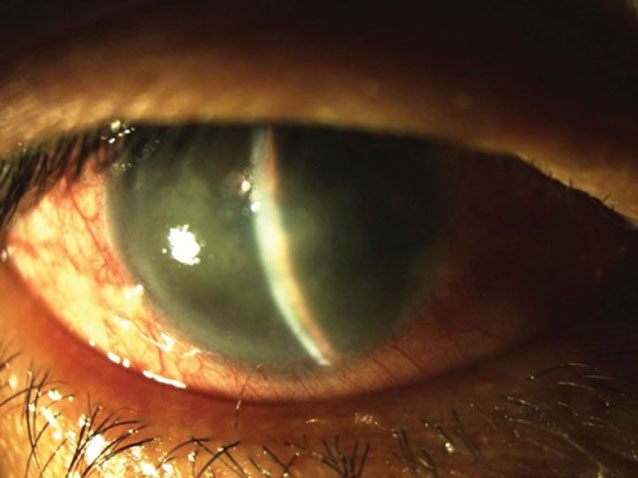 |
|
Corneal edema in an acute angle closure attack. Photo: Joseph W. Sowka, OD. Click image to enlarge. |
It’s commonly understood that patients with deeper anterior chambers are least likely to develop angle closure, and this is in fact borne out by epidemiological studies. However, in the rare case when a patient with a longer axial length is at risk for angle closure, key clinical indicators include a thick peripheral iris, smaller anterior chamber width and larger lens vault. So says a recent study that investigated the anterior segment characteristics of primary angle-closure disease (PACD) in patients with long, medium and short axial length (AL).
A total of 715 PACD and 1,446 normal subjects aged 35 and older, from a population of 6,830 Chinese citizens from primarily rural areas, were analyzed. Ocular data of the right eye were analyzed. AL was categorized into short (<22.0mm), medium (22.0mm to 24.0mm) or long (>24.0mm) subgroups. Demographic and anterior segment parameters of PACD subjects were compared between the three AL subgroups. Logistic regression analysis was performed to identify the risk factors for PACD in the three subgroups.
The study showed that only 6.6% of PACD patients had long AL. They had flatter corneas, lower spherical equivalents, larger anterior chamber dimensions, thinner lenses and less of an anteriorly positioned lens but similar iris parameters compared with those with a relatively shorter AL. No significant differences were found for angle opening distance and iris parameters when comparing the values of eyes with long AL with those of patients with short and medium AL. Significant risk factors for the development of PACD with long AL were peripheral iris thickness, anterior chamber width and lens vault.
The flatter cornea in PACD subjects with long AL could be attributed to horizontal expansion of the eyeball and compensation by decreasing the corneal power in axial myopia, the study authors noted in their paper.
“These findings demonstrated that, in atypical PACD with a long AL and relatively large anterior segment dimensions, a thick peripheral iris, small anterior chamber width and larger lens vault were the most essential risk factors for angle-closure disease,” they wrote. “This study indicated that gonioscopy is essential and should be performed on all suspected glaucoma patients with an increased intraocular pressure, regardless of the AL level and refractive status.”
Zhang Y, Zhang Q, Li ZS. Anterior segment characteristics and risk factors for primary angle closure disease with long axial lengths: the Handan Eye Study. Invest Ophthalmol Vis Sci. 2023;64(1):8. [Epub ahead of print]. |


